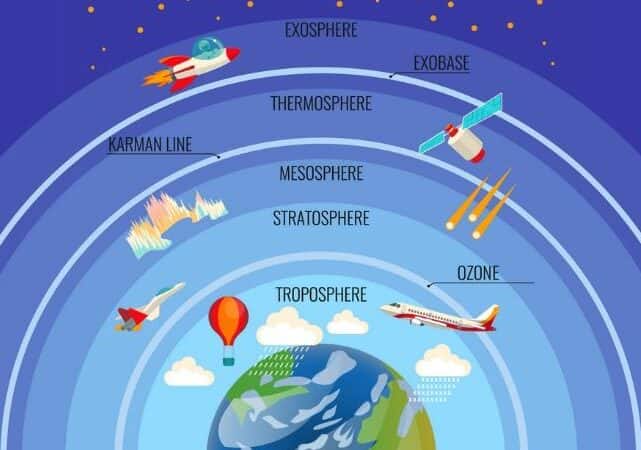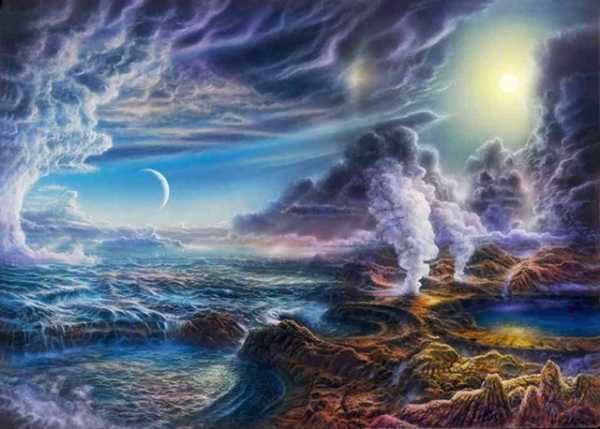The biosphere is the home of living organisms. The emergence of life is closely tied to the evolution of the earth’s crust. It commenced its formation approximately 4 billion years ago, marking the appearance of the first signs of life on our planet.
The formation and gradual development of the biosphere can be attributed to various factors, including the impact of cosmic energy on Earth and the evolution of living organisms and humanity.
The concept of the biosphere was first coined by Austrian scientist Suess in the 19th century, who categorized all the layers of the Earth. However, it was in the 20th century when the Ukrainian scientist V.I. Vernadsky (the inaugural president of the Ukrainian Academy of Sciences) provided a more comprehensive understanding of the biosphere by defining its boundaries and developing a unified doctrine.
Essential Characteristics of the Biosphere for the Origin and Sustenance of Life

- The atmosphere of Earth contains carbon dioxide (CO2) and oxygen.
- Water is a vital component for life on Earth, and it exists in both fresh and saltwater bodies.
- The temperature on Earth is regulated, avoiding extreme highs or lows.
- The biosphere provides food for all living organisms.
There is no universally accepted definition of the biosphere. There are three different interpretations:
- The biosphere encompasses the total mass of all living things that inhabit the Earth’s surface.
- The biosphere consists of organisms and their habitats.
- The biosphere is a result of the long existence of organisms that lived before our time.
Geoscientists argue that the first interpretation is correct since the other two lack theoretical support.
Why is the earth’s atmosphere important?
The Earth’s atmosphere plays a vital role in supporting life on our planet. It has both direct and indirect effects that contribute to its significance. Some of the key reasons why the atmosphere is important include:
- Protection against meteorites: The atmosphere acts as a shield, intercepting and burning up many meteorites before they reach the Earth’s surface.
- Ozone layer: The ozone layer in the atmosphere protects all living organisms from excessive ultraviolet radiation, which can be highly detrimental to their survival.
- Oxygen supply: The atmosphere contains oxygen, which is essential for the existence of living organisms. It enables respiration and supports various biological processes.
- Temperature regulation: The atmosphere acts as a gas shell around the Earth, regulating temperature fluctuations. It prevents extreme heat during the day and excessive cold at night. It also plays a role in the changing seasons.
Let’s explore the underlying significance that emerges from the primary one. Oxygen
All living organisms require oxygen for survival. The average individual cannot go without air for more than 1 minute. Without continuous oxygenation of the cells, they will begin to deteriorate.
The Earth’s temperature equilibrium is maintained by the atmosphere. The lower layer of the atmosphere is warmed by the land and water surfaces, thereby cooling them. When the sun’s rays heat the water, it produces water vapor, which expands and rises to form clouds. Additionally, the entire atmosphere exerts atmospheric pressure on every surface. As a result, living organisms have developed internal pressure during the evolutionary process.
The climate in different areas varies due to the varying effects of sunlight, winds, and surfaces, all of which are influenced by the atmosphere. Permafrost is one of the most powerful climatic phenomena.
However, as humanity advances, we are increasingly impacting the composition of the atmosphere directly. Human activities result in air pollution, which in turn affects the overall climate of the Earth. This phenomenon contributes to global warming.
It can be concluded that the significance of the atmosphere has been underestimated. Mankind has yet to realize the extent to which it relies on a balanced atmosphere. We pollute it without considering the consequences, which can be severe. Global warming is just one link in a chain that will have devastating effects on the planet.
- The Earth’s atmosphere is of considerable size.
- The composition and structure of the atmosphere include oxygen, carbon dioxide, and nitrogen.
- There are three main types of rocks: magmatic, metamorphic, and sedimentary.
- There are different types of lakes, including drainless, draining, and freshwater ones.
- The pollution of the hydrosphere, whether biological or natural, has significant environmental consequences.
- The hydrosphere plays a crucial role in both the Earth and human life.
- The changing of seasons is influenced by various factors and has specific patterns.
- The Earth’s layers consist of the crust, mantle, and core.
Limitations
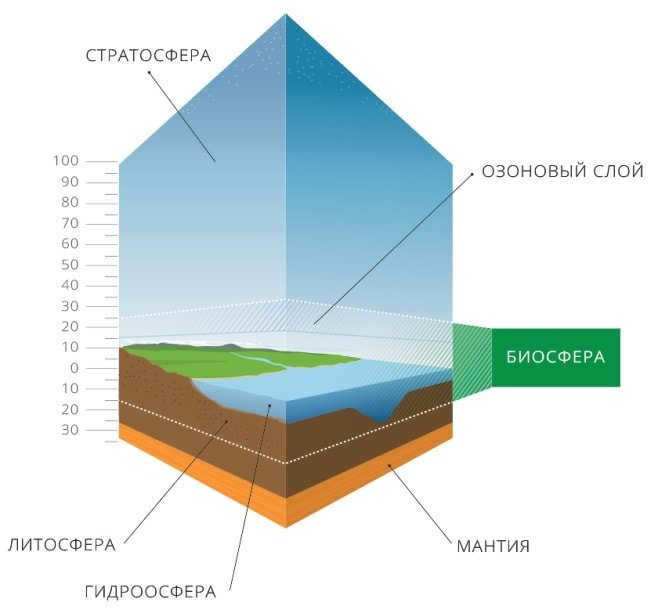
The boundaries of the biosphere are defined by the ability of individuals to survive in the environment. Living organisms are the primary component of the biosphere, and their survival is dependent on certain conditions. The upper boundary of the biosphere is determined by the presence of ultraviolet radiation in the upper layers, which prevents the development of living organisms. On the other hand, the bottom line of life is established by the high temperatures found in the Earth’s depths.
What are the limits of the biosphere?
The biosphere is the layer of our planet that supports life. It includes the atmosphere, which is made up of nitrogen, oxygen, carbon dioxide, and other gases. The atmosphere acts as a protective shield, shielding the Earth from overheating, cosmic radiation, ultraviolet light, and meteorites. The atmosphere is divided into different layers: the troposphere, stratosphere, and ionosphere.
The troposphere, which is the lowest layer of the atmosphere, is also considered the upper boundary of the biosphere. It extends up to an altitude of 20 km.
Above the troposphere, we have the stratosphere, which is located at an altitude of 50 km above sea level. In the stratosphere, the air becomes liquefied and heated, and the concentration of ozone increases. These conditions make it inhospitable for most forms of life.
Finally, we have the ionosphere, which is the uppermost layer of the atmosphere. It is highly ionized due to exposure to cosmic radiation.
The Lithosphere is the Earth’s crust, a solid layer that extends to a depth of 200km. The Biosphere encompasses the upper sphere inhabited by living organisms. The lower boundary of the lithosphere extends to 4 km, where bacteria have been discovered. As we go deeper, the temperature rises to 100 degrees, making it incompatible for life to exist, resulting in protein denaturation and the demise of all living beings.
The Hydrosphere refers to the entirety of surface and underground water. It is one of the Earth’s layers that surrounds continents and islands, constituting 70% of the globe’s surface. The lower boundary of the biosphere is situated at a depth of approximately 11 km, specifically in the Pacific Ocean region.

Diagram illustrating the boundaries of the biosphere
Layers within the biosphere
Eubiosphere – the primary layer of the biosphere. This layer is home to 99.9% of all living organisms. The eubiosphere spans a width of 12-17 km.
Parabiosphere and metabiosphere – the respective upper and lower layers of the bisosphere, where life can occasionally be found, brought in from the eubiosphere.
The apobiosphere and abiosphere – the uppermost and lowest layers where life cannot enter, even by chance.
The classification of living organisms is based on their habitat:
- Aerobiosphere (life sustained by atmospheric moisture and solar energy, from the tops of trees to the stratosphere);
- Hydrobiosphere refers to all water structures that are inhabited by hydrobionts, excluding groundwater.
- Hydrobiosphere encompasses all aquatic environments where hydrobionts reside, except for groundwater.
Role of the Atmosphere in the Biosphere
The atmosphere is a gaseous layer surrounding the planet, comprising a mixture of different gases, water vapor, and dust. It facilitates the exchange of matter between the Earth and the Cosmos. The Earth receives cosmic dust and meteoritic material, while losing lighter gases such as hydrogen and helium. The Sun’s intense radiation penetrates the Earth’s atmosphere, leading to the dissociation of gas molecules and ionization of atoms. The primary constituents of the atmosphere include nitrogen, oxygen, argon, and carbon dioxide.
The layer closest to the Earth’s surface is known as the troposphere. In middle latitudes, the altitude in this layer is about 10-12 km above sea level, while above the equator it is around 16-18 km, and at the poles it is approximately 7-10 km. The temperature in the troposphere decreases by about 0.6°C per 100 m of height, ranging from +40°C to -50°C. It is within this layer, at a height of 9-10 km, that weather phenomena primarily occur. This part of the atmosphere is where rain, most clouds, and the majority of thunderstorms and storms take place.
Additionally, the troposphere contains suspended solid and liquid particles, which are commonly referred to as aerosols.
Above the troposphere lies a layer called the stratosphere, which is approximately 40 kilometers thick. The air in this layer is less dense and has low humidity. The temperature remains constant at around -50°C up to the 30 km mark, and then increases to +10°C at the 50 km mark.
The majority of ozone is found at altitudes of 10-25 km, with the highest concentration occurring at 22-24 km. The ozone layer, also known as the “ozone shield,” plays a crucial role in preserving life on Earth. If this gas was concentrated near the Earth’s surface, it would only form a thin film measuring 2-4 mm. However, this film serves as a protective barrier for us.
The mesosphere is located beyond the stratosphere, at an altitude of over 50 km. In this region, the temperature starts to decrease again, reaching -70°C at around 80 km above the Earth’s surface. Moving even higher, beyond the mesosphere (over 80 km above the Earth’s surface), we find the thermosphere. The thermosphere does not have a specific upper boundary and is characterized by increasing temperatures. At an altitude of 500-600 km, the temperature reaches a scorching +1600°C. In this region, the gases are highly rarefied, and molecular collisions are infrequent, which means that they cannot cause heating of objects present in this zone. However, the atmospheric pressure steadily decreases with altitude. This implies that the air becomes increasingly rarefied as we move higher up. It is interesting to note that 90% of the atmosphere’s mass is concentrated within 16 km above the Earth’s surface.
At a distance of 800-1600 km from the Earth lies the exosphere, which is the farthest layer. Despite its distance, gases can still be detected in this region and there is a continuous leakage of atoms, primarily hydrogen and helium, into space.
Also worth reading: The Ministry of Natural Resources has identified the Russian cities with the highest levels of air pollution (LIST)
Living matter was defined by Vernadsky as the total population of all living organisms that inhabit the planet during a specific time period.
- It possesses an immense amount of energy;
- the rate of reactions within a living organism is faster compared to artificially created conditions;
- the components of living matter remain stable only within a viable organism;
- it has the ability to thrive in diverse conditions, filling all available space. Vernadsky referred to this phenomenon as the “omnipresence of life”;
- individuals are always integral parts of an ecosystem;
- living matter evolves, acquiring new properties and adapting to the ever-changing environment.
Biogenic matter refers to the products generated by the life processes of organisms. As organisms go through their life cycles, they repeatedly interact with all the components of the biosphere, resulting in the formation of deposits such as oil, gas, coal, and peat.
Inorganic matter, on the other hand, is formed without the involvement of living organisms and includes non-biogenic rocks and minerals.
Biocosmatter is a category that encompasses substances created through the interaction of living and non-living matter, such as water, the surface atmosphere, and soil.

The structure and composition of the biosphere
Living matter is not uniformly distributed across the Earth’s surface, with higher concentrations near the equator and less life at the polar regions.
The accumulation of living organisms occurs at the boundaries between different layers of the biosphere. For example, at the bottom of the ocean, there is a boundary between the lithosphere and hydrosphere. In the surface waters of the World Ocean, there is a boundary between the hydrosphere and the atmosphere. And at the boundary between the lithosphere and the atmosphere, there is the soil, which serves as a habitat for microorganisms, insects, and other animals. These locations provide favorable conditions for existence, including a high concentration of oxygen, access to sunlight, moisture, and nutrients.
The proportion of species in the biosphere demonstrates the prevalence of vegetation, which accounts for 99% of all living organisms, while animals make up 1% and humans only contribute 0.0002%.
Composition of the Atmosphere
The atmosphere has a layered structure, with each layer varying in density and temperature.
The upper boundaries of the atmosphere fade into space and are not clearly defined, while the lower boundary is at ground level.
Here are the key characteristics of each layer:
1) Troposphere
- Troposphere – The lowest layer of the atmosphere, where we breathe the air.
- It ranges from 8-10 km thick over the poles, 10-12 km thick in temperate latitudes, and 16-18 km thick over the equator.
- The troposphere contains a significant mass of atmospheric air.
- Movements of air masses occur in two directions: horizontally (wind) and vertically (convection).
- The temperature decreases by 6 degrees Celsius every 100 m in the troposphere.
2) Stratosphere
- The stratosphere is the layer of the atmosphere located above the troposphere, at an altitude of 8 to 50 km.
- No clouds are formed in this layer.
- Stable air currents are present.
- Temperatures start to rise.
- The ozone layer is located in the stratosphere.
Within the stratosphere, there is an ozone layer situated at an altitude of 25 to 35 km.
The ozone layer absorbs ultraviolet rays, preventing them from reaching the Earth’s surface (the ozone layer is crucial, as high doses of ultraviolet light can be harmful to living organisms).
3) Mesosphere
4) The Thermosphere
5) The Exosphere
- Situated above 800 km
- Gradually transitions into outer space
- Comprised of the lightest gases (hydrogen, helium).
Functions of the biosphere
Energetic – The accumulation of solar radiation through photosynthesis (the conversion of sunlight energy into organic compounds using plant pigments) and its subsequent distribution among all living organisms.
Gas-forming – Maintaining a stable gas composition in the atmosphere (releasing oxygen, absorbing carbon dioxide).
Concretionary – Concentrating chemicals in the body and later forming minerals.
Troposphere
The troposphere, which is the closest layer to Earth’s surface, is also the densest layer of the atmosphere. It contains approximately 75% of the total mass of the atmosphere, which is estimated to be around 5×10^18 kg.
Depending on the region of the Earth, the thickness of the troposphere can vary from 8 km to 14 km. The thinnest areas, with a thickness of about 8 km, are located at the north and south poles.
Being the lowest layer of the atmosphere, the troposphere plays a crucial role in supporting life on the planet and is where most climatic events take place. The term “troposphere” originates from the Greek word “tropos,” meaning “change,” which reflects the dynamic nature of climate change and the behavior of this atmospheric layer.
The boundary between the troposphere and the stratosphere is known as the tropopause. The tropopause can be easily recognized by the distinct pressure distribution patterns and temperature differences in each layer.
Troposphere Composition
The troposphere is primarily composed of 78.08% nitrogen, 20.95% oxygen, 0.93% argon, and 0.04% carbon dioxide, by volume. Additionally, the air in the troposphere contains varying amounts of water vapor, which enters through the process of evaporation.
Tropospheric Temperature
The temperature in the troposphere decreases as altitude increases, similar to pressure. This phenomenon occurs due to the absorption of solar energy by the Earth’s surface, which heats the lower levels of the troposphere. As warmer regions experience higher rates of evaporation, water vapor is more commonly found at sea level and less frequently at higher altitudes.
Here are a few illustrations of what can be observed in the troposphere:
- Weather conditions;
- Precipitation including rainfall, snowfall, and hailstorms;
- Atmospheric gases such as nitrogen, oxygen, argon, and carbon dioxide;
- Cloud formations;
- Aerial creatures.
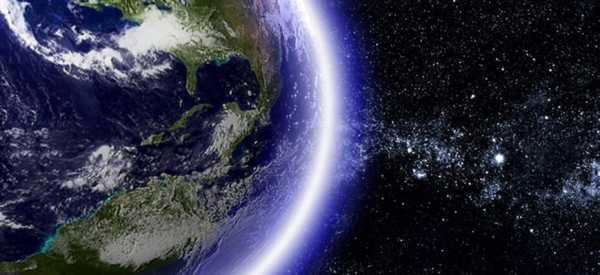

Our planet, Earth, is enveloped by a myriad of gases that form its atmosphere. This atmosphere is heterogeneous, dynamic, and extremely susceptible to the impacts of living organisms. Its inner surface interacts with the hydrosphere, while its outer surface is almost akin to the vastness of outer space. Throughout its existence, the composition of Earth’s atmosphere has constantly undergone changes due to numerous factors. It is worth noting that the climate on our planet and the very existence of all living beings heavily rely on this delicate equilibrium.
What is the origin of the Earth’s atmosphere?
The Earth’s atmosphere plays a crucial role in safeguarding us from the perils of the vast cosmos. It acts as a shield against harmful radiation, incoming meteorites, and helps regulate the planet’s temperature. The greenhouse effect caused by the reflection of the Sun’s rays off the clouds has contributed to an increase in the Earth’s temperature by approximately 30 degrees. Moreover, the diverse composition of the atmosphere has been essential for the emergence of life. This sets Earth apart from other planets which lack a comparable atmosphere. But what is the reason behind the existence of our planet’s atmosphere?
The atmosphere’s thickness is estimated to be over 120 kilometers, and it contains an enormous amount of air – 5.3*1018 kg. This vast volume is a result of the diverse gases that make up its composition, which include almost all elements on the periodic table. However, the Earth’s atmosphere didn’t always exist in its current form. In the past, the planet’s surface was covered in craters caused by meteorite impacts, which easily penetrated the thin protective layer surrounding the Earth. Initially, the atmosphere consisted solely of hydrogen and helium, but over time, with the help of erupting volcanoes, it gained additional gases such as ammonia, methane, carbon dioxide, sulfur, and nitrogen. These gases now make up 78 percent of the atmosphere’s total mass.
Living beings
The Earth’s atmosphere came into existence thanks to the combined efforts of the planet and living beings. While the planet ensured the presence of various gases, the living beings started actively producing oxygen, preventing it from simply dissipating. Consequently, over billions of years, oxygen came to occupy 21 percent of the atmosphere’s mass.
However, the participation of living organisms did not cease at that point, and they commenced utilizing carbon to construct their own skeletal structures. The Earth’s crust was effectively saturated with strata of organic matter and fossilized remnants. Simultaneously, the quantity of carbon dioxide experienced a significant reduction, while the levels of oxygen continued to rise. As a result, the Earth’s ozone layer materialized, assuming the responsibility of safeguarding all living organisms from the harmful impacts of ultraviolet radiation. Subsequently, life on Earth flourished, and an array of more complex life forms began to emerge.
The impact of the atmosphere on the Earth’s appearance
Whenever one gazes up at the azure sky, a question inevitably arises: why is it blue? The answer, once again, can be found in the atmosphere. Oxygen has the ability to disperse short wavelengths, resulting in the creation of a blue hue. While other gases can also produce this effect, it is not nearly as pronounced. This phenomenon can even be observed from outer space, where the Earth seems to be enveloped in a bluish mist.
Furthermore, the lithospheric plates and volcanoes play a vital role in explaining the existence of the Earth’s atmosphere, as they are the primary sources of the noble gas Argon. Despite its volatility, Argon only constitutes 1 percent of the total atmospheric mass. It rises to the upper layers and ultimately escapes into space. A similar process occurs with helium as well.
The climate has undergone numerous transformations throughout history, each of which has had a significant impact on the evolution of life. However, certain changes are remarkably resilient and can persist in almost any circumstances. One such example is the ozone layer, which environmentalists warn could be destroyed if human activities continue to be harmful. Even in the event of a drastic reduction in atmospheric oxygen levels, such as a hundredfold decrease, the ozone layer would still persist. This indicates that humanity has only made a small imprint on the planet’s history, although in specific regions, this issue can greatly affect people’s quality of life. For instance, the smog enveloping Beijing forces its residents to inhale polluted air. Nevertheless, the ozone layer will continue to safeguard the Earth from ultraviolet radiation regardless.
As stated earlier, the atmosphere is comprised of a mix of gases that create a protective barrier. However, the Earth’s atmosphere is divided into distinct layers, each with its own distinct characteristics.
The Troposphere
The arrangement of gases in the atmosphere
The first layer of the atmosphere, situated between 0 and 20 kilometers, is known as the troposphere. Its elevation varies depending on the season and latitude. This particular layer contains around 80 percent of the total air and 90 percent of the water vapor. Various atmospheric phenomena such as turbulence, convection, cloud formation, and cyclones occur within the troposphere. The temperature also changes with altitude. According to scientific studies, the temperature decreases by 0.65 degrees Celsius for every 100 meters of increased altitude.
Which atmospheric layer is closest to the Earth’s surface? As mentioned earlier, it is the troposphere. The proximity of the troposphere to the ground has a significant impact on the creation of weather patterns. It is in this layer that the Earth’s surface influences wind patterns, pressure variations, and the formation of irregularities and elevations. Additionally, the troposphere plays a crucial role in the water cycle, as it acts as a massive water filter. As water evaporates from the oceans, it eventually returns to them, ensuring the continuous flow of water throughout the planet.
The boundary between the troposphere and the stratosphere
At this boundary, the temperature stops decreasing with increasing altitude, marking the end of the troposphere’s role.
The layer above the tropopause
Located between 8 and 50 kilometers above the Earth’s surface, the stratosphere is characterized by a lack of water vapor and significant variations in atmospheric pressure. Additionally, the air in this layer is heated to temperatures ranging from 0 to 1 degrees Celsius. It is also a common flight path for airplanes in the lower stratosphere.
It’s incredible that living creatures are able to survive at such high altitudes. The most common organisms found there are aeroplankton, although there have been instances where different types of vultures have been trapped in airplane turbines, and certain types of ducks can even fly over Everest.
Stratopause
The stratopause is another intermediate layer where the temperature drops to freezing at 0 degrees Celsius.
Ozone layer
The earth’s atmosphere also contains the “shield” that safeguards all life, as mentioned earlier. It is situated precisely between the stratosphere and mesosphere.
Mesosphere
The mesosphere is the least explored and most perilous section of the atmosphere. The excessive low pressure and thinning of the air are to blame. Balloons come to a halt, suspended in place, while jet airplanes lose their functionality due to the absence of aerodynamics. Flight remains feasible only for rockets and rocketplanes. Even satellites cannot linger in this atmospheric layer for long, often disintegrating here.
Consequently, little is known about the mesosphere, except that it serves as the incineration site for most meteorites that descend onto Earth.
The mesopause
An intermediate region of the atmosphere with air temperatures around -90 degrees Celsius.
Karman Line
The conceptual boundary between space and the atmosphere, situated at an altitude of 100 km above sea level.
Thermosphere
A layer that begins at the Karman line and extends up to 800 km. It is characterized by extremely high temperatures, reaching up to 1600 degrees Celsius. These temperatures do not pose a threat to space shuttles due to two main factors: 1) the extremely low concentration of air in this region, creating a vacuum effect; 2) the presence of radiators on all flying vehicles, which help dissipate excess heat energy.
Thermopause
The thermopause is the upper boundary of the thermosphere, where solar radiation is virtually not absorbed and the temperature remains constant regardless of altitude changes.
Exosphere
The exosphere marks the end of the atmospheric layers and is located at an altitude of 800 kilometers. In this region, the atmosphere is composed of ionized hydrogen atoms due to solar radiation, resulting in extremely low density and pressure. The exosphere extends into the Earth’s corona, spanning 100 thousand kilometers from the planet’s surface.
Characteristics of the earth’s atmosphere and its impact on humans
We have already established which layer of the atmosphere is closest to the earth, but the effect of the atmosphere on humans is still not fully understood. When a person ascends to an altitude of over 5 kilometers, they may experience oxygen deprivation, which is especially pronounced in untrained individuals. As a result, their mental and physical capabilities will significantly decline, and breathing will become impossible at around 9 kilometers, even though there is still oxygen present up to 115 kilometers.
If you go beyond the height limit of 20 km, the water and fluids between cells in the human body will start to boil, resulting in rapid death. The definition of “outer space,” where humans cannot survive without special equipment, begins at 15 km altitude.
The troposphere and stratosphere serve as protective barriers, shielding the Earth from harmful radiation. Without them, the ultraviolet spectrum at an altitude of 40 km would impact humans and the Earth’s surface, leading to the extinction of all living beings.
Once you surpass the 60 kilometer threshold, normal phenomena such as sound propagation, aerodynamics, and heat transfer would cease to exist, as they can only occur within the lower atmosphere.
Once the altitude reaches 100 kilometers, there is no other way to transfer heat except through thermal radiation. This means that spaceships, airplanes, and other similar devices can no longer be cooled internally, rendering air radiators useless.
What about clouds, though?
The atmosphere is a crucial component of our planet and is responsible for the existence of life. However, the formation of the atmosphere would not have been possible without the influence of the Earth’s water surface. Water is present in the seas, oceans, rivers, and even in the air. The atmosphere contains approximately 5.2 * 10^15 kg of water, including water vapor, gas, and ice crystals. Clouds, due to their massive size, can hold hundreds of tons of water.
These formations can be observed from space, even with the naked eye. This is because more than half of the Earth’s surface is covered by clouds. It’s worth noting that these clouds also have an impact on the planet’s heat exchange. During winter, they absorb sunlight and, thanks to the greenhouse effect, increase the planet’s temperature. In summer, however, the presence of clouds blocks a significant amount of the Sun’s energy.
It is important to mention that deserts, lacking clouds, allow the heat accumulated during the day to quickly escape from the planet’s surface. In other regions, on the other hand, clouds play a role in regulating nighttime temperatures.
The issue of air pollution
While the impact of humans on the planet as a whole may be minimal, the significant increase in carbon dioxide levels in recent times cannot be ignored. This increase is primarily due to the active burning of fossil fuel reserves that have been accumulating for centuries as a result of the decomposition of other living organisms.
Although carbon dioxide is absorbed by the oceans and plays a role in the photosynthesis process, its levels have already risen by 10 percent in the last century alone. If this rate continues to increase, it could have serious implications for global climate patterns.
Furthermore, there exists aerosol pollution caused by volcanic eruptions, dust storms, and the dispersion of plant pollen. However, there are also artificial sources of pollution, such as fuel combustion, cement usage, and mining. The exportation of particulate matter into the Earth’s atmosphere is likely to have a significant impact on global climate change.
The Earth’s atmosphere acts as a gaseous protective shield encompassing the entire planet (the term itself is derived from the Greek words “vapor” and “ball”).
In general, it extends from the Earth’s surface to a distance of thousands to 10 kilometers. However, the term “atmosphere” typically refers only to the part that rotates with the planet around its axis (this encompasses an area approximately 1000-1300 km from the surface).
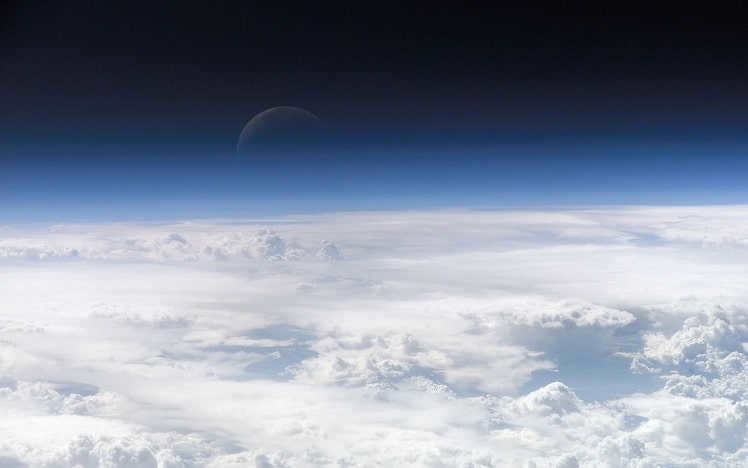

While many individuals consider the boundary to be at 118 kilometers above sea level and everything below it as the atmosphere, this definition is also accurate.
Earth’s atmosphere: Structure and composition
The structure of the atmosphere surrounding our planet is quite intricate, consisting of various layers with distinct properties.
These layers differ in terms of their elemental composition, mass, pressure, temperature, and other parameters. For instance, the troposphere, the lowest layer, constitutes approximately 80% of the atmosphere’s mass, while the thermosphere boasts the highest temperature, reaching up to 1200°C.
The composition of our planet’s atmosphere includes various gases and substances, such as dust, water droplets, ice particles, and combustion products. However, nitrogen and oxygen are the primary components, accounting for 78% and 21% of the volume, respectively.
Processes and Phenomena in the Atmosphere
By studying the atmosphere, it becomes feasible to analyze fluctuations in weather patterns and climate. This field of study encompasses two disciplines – meteorology and climatology.
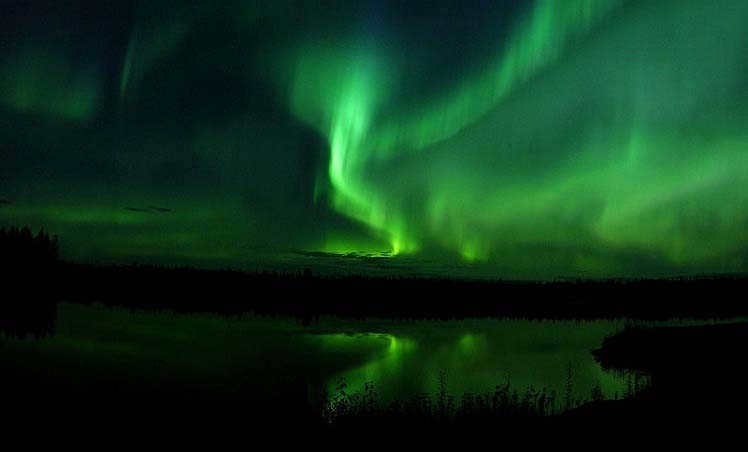
The prediction of various atmospheric phenomena, such as precipitation, fog formation, lightning, tornadoes, and more, is made possible through the calculation of multiple parameters including atmospheric pressure, air humidity, temperature, wind speed, and others. This calculation allows for a relatively accurate forecast due to the consideration of these factors.
Physical characteristics of the Earth’s atmosphere
The Earth’s atmosphere contains oxygen up to an altitude of approximately 115 kilometers above sea level. However, for most individuals, reaching a height of 5 kilometers is already challenging due to the onset of oxygen deprivation (for those who are untrained). Breathing becomes almost impossible at an altitude of 9 kilometers.
At a mere 20 kilometers above ground, an individual exposed to the open air would instantly perish. This is because the pressure of oxygen gradually declines as altitude increases, while the pressure of carbon dioxide and water in our lungs remains relatively constant. Consequently, at 20 kilometers above ground, bodily fluids begin to boil (unless you are inside a sealed cabin). These are the unique characteristics of gas interaction.
The air becomes thinner as you move higher up from the Earth’s surface. Once you reach an altitude of approximately 100 kilometers, the usual principles of aerodynamics no longer hold true. Additionally, at this height, sound waves are unable to travel.
At the same altitude, heat cannot be transferred through any method other than thermal radiation. The mixing of air (convection), which occurs in the lower atmosphere, is simply not possible.
Issues with the Earth’s Atmosphere
There are numerous concerns surrounding the Earth’s atmosphere. Some are a result of human activities, while others are caused by various factors. Nevertheless, these issues can have significant repercussions on individuals’ lives.
Atmospheric problems encompass air pollution, depletion of the ozone layer, global warming, and more.
© Naturae.ru, 2015-2023
Unauthorized reproduction of content from this website is only allowed with an active hyperlink to the original source.
Only when we experience a powerful breeze or are in close proximity to a fan can we truly sense the presence of air. The composition of air is primarily comprised of nitrogen and oxygen, with smaller amounts of argon, water, hydrogen, and carbon dioxide. In terms of percentages, nitrogen accounts for 78.08%, oxygen for 20.94%, argon for 0.93%, carbon dioxide for 0.04%, neon for 1.82*10-3%, helium for 4.6*10-4%, methane for 1.7*10-4%, krypton for 1.14*10-4%, hydrogen for 5*10-5%, xenon for 8.7*10-6%, and nitrous oxide for 5*10-5%.
The air contains a high concentration of oxygen, which is crucial for the functioning of the human body. When we breathe, oxygen enters our body’s cells and takes part in the oxidation process, resulting in the release of energy that is essential for life. Additionally, oxygen in the air is necessary for the combustion of fuel, which generates heat, as well as for obtaining mechanical energy in internal combustion engines.
During the process of liquefaction, inert gases are also separated from the air. If we consider the percentage of oxygen and nitrogen in the air, it is 98 percent. This leads us to wonder, what other gaseous substances are present in the composition of air.
In 1754, a scientist named Joseph Black made a significant discovery, confirming that the air is not a homogeneous substance as previously believed, but rather a mixture of gases. The composition of air on Earth includes methane, argon, carbon dioxide, helium, krypton, hydrogen, neon, and xenon. It is important to note that the percentage of these gases in the air may vary slightly depending on geographical location.
Regrettably, the level of carbon dioxide in big cities is expected to be higher compared to rural areas or forests. This raises the question of how much oxygen is present in mountain air. The answer is straightforward: oxygen is significantly denser than nitrogen, resulting in a lower concentration at higher altitudes due to the decreasing density of oxygen.

Oxygen levels in the atmosphere
When it comes to the oxygen levels in the atmosphere, there are certain standards to consider, especially in work environments. In order for individuals to be able to work efficiently, the recommended oxygen levels in the air range from 19 to 23 percent. It is crucial for enterprises to ensure the tightness of their equipment and machinery in order to maintain these levels. If the oxygen levels in a room where people are working drop below 19 percent during air testing, it is essential to evacuate the area and activate emergency ventilation. To monitor the oxygen levels in the workplace, you can enlist the services of the “EcoTestExpress” laboratory to conduct a chemical analysis of the air.
Now, let’s establish the definition of oxygen
Oxygen, an element found in the periodic table of elements created by Mendeleev, lacks any discernible odor, taste, or color. Oxygen plays a vital role in human respiration and is also crucial for combustion. It is a well-known fact that without air, no materials can burn. Oxygen’s composition consists of a combination of three stable nuclides, each with a mass number of 16, 17, and 18.

Therefore, oxygen is the most abundant element found on our planet. The largest proportion of oxygen can be found in silicates, comprising approximately 47.4% of the solid earth’s crust. Additionally, a significant amount of oxygen is present in both sea and freshwater bodies, accounting for 88.8% of their composition. In contrast, the atmosphere contains only 20.95% oxygen. It is worth mentioning that oxygen is a component of over 1500 compounds found in the Earth’s crust.
In terms of obtaining oxygen, it is obtained through the process of separating air at low temperatures. This process involves compressing the air using a compressor, resulting in an increase in temperature. The compressed air is then cooled to room temperature before being allowed to expand freely.
And here comes another question about the relative weight of oxygen and carbon dioxide. The answer is quite simple – carbon dioxide is heavier than oxygen. Carbon dioxide has a density of 1.97kg/m3, while oxygen has a density of 1.43kg/m3. Carbon dioxide plays a significant role in the vital processes of all living organisms on our planet and also affects the carbon cycle in nature. It has been scientifically proven that carbon dioxide is involved in regulating respiration and blood circulation.

What is carbon dioxide?
Let’s dive into the details of what carbon dioxide is and also discuss its composition. Carbon dioxide, in simpler terms, is a gas that is colorless and has a slightly acidic smell and taste. In terms of its presence in the air, carbon dioxide makes up about 0.038 percent of the air’s composition. When it comes to its physical properties, carbon dioxide cannot exist in a liquid state under normal atmospheric pressure; it goes directly from a solid to a gaseous state.
Dry ice is another name for carbon dioxide in its solid state. Currently, carbon dioxide plays a significant role in the issue of global warming. The burning of different materials is the main source of carbon dioxide emissions. It is important to mention that in the industrial manufacturing process, carbon dioxide is compressed and stored in cylinders. These cylinders are then used for various purposes, including fire extinguishing and the production of carbonated water. Additionally, carbon dioxide is utilized in pneumatic weaponry. In the food industry, it is commonly employed as a preservative.
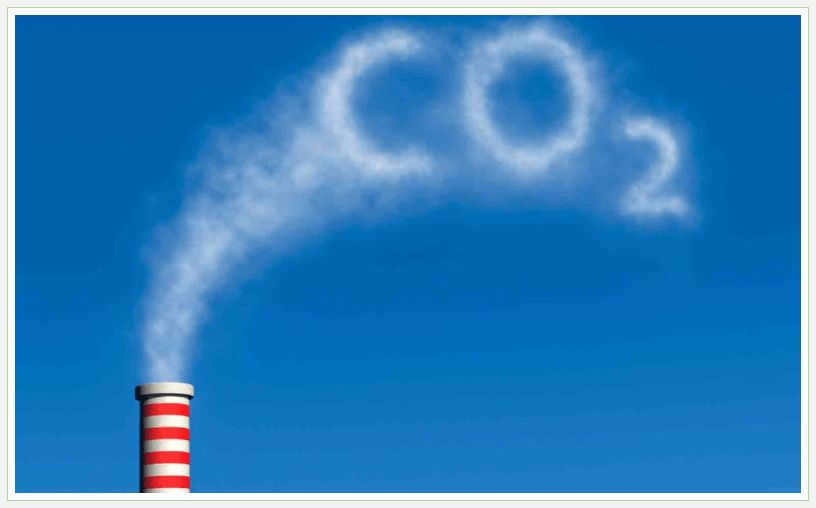
The Components of Inhaled and Exhaled Air
Let’s now examine the components of inhaled and exhaled air. First, let’s define what respiration is. Respiration is a complex and continuous process that constantly renews the gas composition of the blood. The composition of inhaled air consists of 20.94 percent oxygen, 0.03 percent carbon dioxide, and 79.03 percent nitrogen. However, the composition of exhaled air contains only 16.3 percent oxygen, 4 percent carbon dioxide, and 79.7 percent nitrogen.
Dry oxygen enhances the electrical and protective characteristics of the films by eliminating water, promoting densification and reducing volumetric charge. Moreover, in regular conditions, dry oxygen does not react with gold, copper, or silver. For conducting chemical analysis of air or other laboratory investigations, including a comprehensive examination of water quality, you can rely on our laboratory, “EcoTestExpress”.


The Earth’s atmosphere is made up of various gases. It is important to understand what gases are present in the air and in what proportion. The composition of air consists of a combination of different gases, each with its own percentage. These percentages remain relatively constant across different regions of our planet.
Air is made up of not only a mixture of gases, but also various aerosols and vapors. The composition of air is determined by the percentage of oxygen, nitrogen, and other gases present. So, if you’re wondering how much oxygen is in the air, the answer is simply 20 percent. Nitrogen, on the other hand, makes up the majority of the air’s composition, and it’s worth noting that at high pressures, nitrogen can have narcotic effects.
This is particularly important for divers who often work at great depths under high pressure. Oxygen, on the other hand, is crucial for human life on our planet. It’s worth mentioning that inhaling air with higher levels of oxygen for short periods of time does not have any impact on a person.
However, when an individual is exposed to elevated levels of oxygen in the air for an extended period, it can result in pathological alterations within the body. Another crucial constituent of the atmosphere, which has already been extensively discussed, is carbon dioxide. Surprisingly, living without carbon dioxide is just as impossible as living without oxygen.

